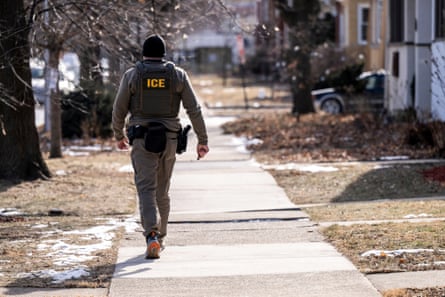Criminal Justice And Human Rights Law Blog
I publish an "Editorial and Opinion Blog", Editorial and Opinion. My News Blog is @ News . I have a Jazz Blog @ Jazz and a Technology Blog @ Technology. My domain is Armwood.Com @ Armwood.Com.
What To Do When You're Stopped By Police - The ACLU & Elon James White
Know Anyone Who Thinks Racial Profiling Is Exaggerated? Watch This, And Tell Me When Your Jaw Drops.
This video clearly demonstrates how racist America is as a country and how far we have to go to become a country that is civilized and actually values equal justice. We must not rest until this goal is achieved. I do not want my great grandchildren to live in a country like we have today. I wish for them to live in a country where differences of race and culture are not ignored but valued as a part of what makes America great.
Sunday, April 06, 2025
Trump Live Updates: Judge Says ‘Grievous’ Deportation Error Must Be Reversed - The New York Times
Trump Administration Live Updates: Judge Says ‘Grievous’ Deportation Error Must Be Reversed

"Where Things Stand
Mistaken deportation: A federal judge called the deportation of a Maryland man to a notorious Salvadoran prison a “grievous error,” adding that the Trump administration’s conduct “shocks the conscience.” The judge has ordered the government to return the man, Kilmar Armando Abrego Garcia, but the administration has said it can do little to bring him back and asked an appeals court to halt the order. Read more ›
Measles death: Health Secretary Robert F. Kennedy Jr. attended the funeral of an 8-year-old who last week became the second confirmed death from the disease in a decade. Mr. Kennedy, a vaccine skeptic who has emphasized untested treatments like cod liver oil, wrote on social media that vaccination was “the most effective way to prevent the spread of measles.” Read more ›
Defending tariffs: Top administration officials sought to defend President Trump’s expansive tariffs during television appearances, dismissing the turmoil in financial markets and downplaying the chances they will lead to higher prices. The administration has offered mixed signals about using the tariffs as negotiating tools, while nations including Vietnam seek to strike deals with the United States."
How RFK Jr. is weakening America’s childhood vaccine system – NBC Chicago
Last week, Jackie Griffith showed up at her office at the Collin County Health Care Clinic in north Texas ready to start her day — answering emails from local doctors before heading to a nearby high school to go over the latest vaccine record requirements.
Instead, the 60-year-old registered nurse was called into her director’s office and told to pack up her belongings. The federal government had yanked funding, she learned, and her position — supporting vaccination efforts for uninsured children through a network of more than 60 providers — was gone.
Across the country in New Hampshire, Kayla Hogan, 27, was hearing the same. She worked for the state’s Department of Health and Human Services, onboarding clinics and hospitals into a data system that would help them administer free childhood vaccines. Now that project was in jeopardy, threatening the process of getting children vaccinated.
As deportations ramp up, immigrants increasingly fear Ice check-ins: ‘All bets are off’ | Trump administration | The Guardian
As deportations ramp up, immigrants increasingly fear Ice check-ins: ‘All bets are off’
"Data suggests as many as 1,400 people were arrested during or right after Ice check-ins in first four weeks of Trump’s administration

Jorge, a 22-year-old asylum seeker from Venezuela, reported in February to the US Immigration and Customs Enforcement (Ice) field office in Portland, Oregon, for what he figured would be a routine check-in. Instead, he was arrested and transferred to a detention center in another state.
Alberto, a 42-year-old from Nicaragua who had been granted humanitarian parole, checked in with Ice using an electronic monitoring program that same month. Three days later, he was arrested.
Sergei and Marina, a young couple from Russia with a pending asylum case, went into an immigration office in San Francisco in March, thinking they needed to update some paperwork. Agents arrested Sergei and told Marina to come back in a few weeks.
For years, immigrants of all sorts with cases in process, pending appeals or parole, had been required to regularly check in with Ice officers. And so long as they had not violated any regulations or committed any crimes, they were usually sent on their way with little issue. Now, as the Trump administration pushes for the mass arrest and deportation of immigrants, these once routine check-ins have become increasingly fraught.
Ice does not appear to keep count of how many people it has arrested at check-ins. But the Guardian estimates, based on arrest data from the first four weeks of the Trump administration, that about 1,400 arrests, or about 8% of the nearly 16,500 arrests in the administration’s first month – may have occurred during or right after people checked in with the agency.
The Guardian reviewed cases in the arrest data, which was released by the Deportation Data Project from UC Berkeley Law School, where people who had previously been released on supervision were now arrested, as well as cases of people with pending immigration proceedings who were arrested in their communities. According to immigration lawyers, these types of arrests are most likely to match arrests that are occurring during or shortly after check-ins – though the actual number of cases may be higher.

“Essentially, these people are low-hanging fruit for Ice,” said Laura Urias, a program director and attorney at the legal non-profit ImmDef. “It’s just very easy to arrest them.”
Under the Biden administration, immigration officials had been instructed to prioritize detaining and expelling people who posed threats to public safety, and had criminal records. There were arrests during Ice check-ins during the Biden administration, too. A Guardian analysis found there were 821 arrests per month, on average, in 2024 that appeared to have occurred during or right after check-ins. But officials often used their discretion to allow immigrants who weren’t considered a priority for deportation to remain in their communities, on orders of recognizance or supervision.
One of Donald Trump’s first actions after he was sworn in for his second term was to broaden Ice’s mandate – now all immigrants without legal status are prioritized for arrest, including those who have been checking in and cooperating with authorities.
“Under this new administration, all bets are off,” said Stefania Ramos, an immigration lawyer based in Seattle. “So anyone with an Ice check-in appointment is frantic, looking for a lawyer, trying to figure out what they can do to protect themselves.”
Attorneys and advocates cannot advise clients to skip check-ins because doing so would mean violating immigration regulations. And because these immigrants have been complying with Ice requirements, the agency knows their current home and work addresses. Many under Ice supervision had been ordered to wear ankle monitors or use facial recognition apps to check in – and allow the agency access to their real-time whereabouts.
But lawyers are advising clients to prepare for the possibility that they could be detained at check-ins, and to bring someone, either a family member or an attorney, along with them.
Jorge, the 22-year-old from Venezuela, had been checking in with Ice every three months while awaiting a court date to assess his asylum case. “Truly, I was never afraid I’d be arrested, because I did everything right,” he said on the phone, from the detention center in Tacoma where he is now being held.
When an immigration official in Portland summoned him to sign some paperwork on 20 February, he had no reason to think he’d be relocated to a detention center one state over. “The truth is, this is so crazy,” he said. “I have a clean record. That’s why I voluntarily went to Ice.”
In detention, he’s seen glimpses of the news that the president has declared war on Venezuela’s Tren de Aragua gang, that Venezuelan men with no criminal convictions were being sent to a mega-prison in El Salvador. “I’m afraid,” he said. He isn’t from the state in Venezuela where Tren de Aragua operates, and he has no tattoos – which the government has spuriously cited as evidence that men are members of a gang. “But I don’t know what to think. It feels like I am being unjustly imprisoned simply for being Venezuelan.”
Jorge had himself fled violence back home. He had first escaped to Colombia in 2022, but he had found it impossible to make money and survive there. That year, he continued north, through the Darién jungle, to Panama, but eventually decided to return home to Venezuela when he realized the US was enforcing its “remain in Mexico” policy, sending migrants arriving at the southern border back to Mexico. “I was back for only three months, but I was living a nightmare. I had to leave,” he said. He witnessed multiple homicides and was harassed by local law enforcement. “I was afraid for my life.”

He crossed through the Darién Gap again in 2023, and registered an asylum claim and was given a court date in 2025. In the two years since, he enrolled in community college and completed the accredited irrigation program in partnership with Portland Community College, worked as an advocate with the Voz Workers’ Rights Education Project and trained in emergency preparedness. He danced bachata and played on pick-up sports teams in town. “I left my family in Venezuela, but I found my community in Portland,” he said.
“Now I feel despair. My future is literally hanging in the balance,” he said. On 20 March, a judge denied his appeal for bond – which means he will likely have to remain in detention until September, unless his lawyers are able to successfully appeal. Meanwhile, his friends have been raising money to cover legal expenses and commissary funds in detention.
“I’m trying to keep courage,” he said. “But I don’t know why I’m here.”
More than a dozen immigration lawyers, advocates and former immigration officials that the Guardian interviewed for this story said they have been hearing of similar cases across the country.
ImmDef, which maintains a rapid response hotline for the families of people who have been detained, has received several calls from people who said their loved ones were arrested at check-ins. But the organization has also seen a number of cases where people went to their check-ins, and encountered no problems.
“It hasn’t been consistent,” said Urias. “We haven’t seen much of a pattern, per se.”
Ice did not respond to questions about whether its agents are increasingly arresting people at check-ins, or whether the frequency of these check-ins had changed, though the agency acknowledged it received the Guardian’s query.

Urias was especially worried for one of her clients, a woman who survived domestic violence. She has a removal order but a pending application for a U-visa, which is offered to the victims of certain crimes.
“She had been checking in with Ice since 2016, we actually survived the first Trump administration,” said Urias. Normally, Urias doesn’t accompany her to the check-ins but did so earlier this month. But then, the check-in happened without incident – and she was told to come back in a year. “It was a huge relief,” said Urias. “But also it feels like there’s no rhyme or reason why some people are ok, and others are picked up.”
Lawyers and advocates said people such as Urias’s client – who have been given prior “orders of removal” by Ice, but were allowed to remain in the US because they had pending cases or appeals, because they had children or family in the US under their care, or because home countries weren’t accepting deportation flights – were among the most vulnerable to deportation at the moment.
Ice always had the power to execute removal orders at any time – and now the agency seems particularly poised to wield that power.
That’s what worries Inna Scott, an immigration attorney in Seattle, whose client had crossed into the US from Mexico as a teenager, and was issued a deportation order in 1997. But he has continued to live in the US since then. In 2021, he was able to get a permit to work legally in the US after complying with Ice’s orders to regularly check in.
When he reported, as usual, in March this year, immigration officials told Scott that they would likely seek to enforce her client’s removal order from the 90s, and instructed them to return in a month. “My client has no criminal history and has been a well-behaved resident of the country for decades,” she said. “But now he’s all of a sudden subject to detainment.” Ice could reinstate his old deportation order without giving him any opportunity to make his case in front of an immigration judge.
Scott said she wasn’t particularly shocked because Ice officials made similar arrests during the first Trump administration – which had also issued a broad mandate to deport anyone without legal status. “But it is unfortunate. These are people without any kind of criminal history. These are people who are not national security risks. They’re not fugitives, they are living their lives working lawfully, with their work permits,” she said. “And they’re still being uprooted from their lives and taken to a country they haven’t been to in decades.”
A Nicaraguan asylum seeker checked in with Ice every week. He was arrested anyway | US news | The Guardian
A Nicaraguan asylum seeker checked in with Ice every week. He was arrested anyway
"Alberto Lovo Rojas fled violence in his home country. Now, he fears Trump-backed deportation

It finally happened while he was waiting to get his hair cut.
Alberto Lovo Rojas, an asylum seeker from Nicaragua, had been feeling uneasy for weeks, worried that immigration officials would arrest him any moment. But he had pushed the worry aside as irrational – after all, he had a permit to legally work in the US, and he had been using an app to check in monthly with Immigration and Customs Enforcement (Ice).
Still, something felt off. The Trump administration had promised mass deportations, and in the weeks since Donald Trump’s inauguration, Ice had asked him to do extra check-ins each weekend. “I even messaged the Ice office through my app, to ask if something was wrong,” Rojas said.
His last check-in with Ice was on 5 February – all normal. On 8 February, they came for him.
He was outside Great Clips in the Lincoln Heights neighborhood of Spokane, Washington. The barbershop had been crowded, so he put his name down for a cut and decided to wait in his car.
Hours later, he was moved into the north-west detention center in Tacoma, awaiting deportation to Nicaragua – which he fled in 2018 amid a violent crackdown against nationwide anti-government protests. Rojas fears he’ll be targeted again.
“I’m afraid to go back, I’m afraid for my life,” he told the Guardian. “I’m afraid I will never see my children again.”
Rojas, 42, is one of potentially hundreds of people who have been detained in recent weeks despite complying with Ice requirements to regularly check-in. Ice does not appear to keep count of how many people it has arrested at check-ins. But the Guardian has estimated, based on arrest data from the first four weeks of the Trump administration, that about 1,400 arrests – 8% of the nearly 16,500 arrests in the administration’s first month – have occurred during or right after people checked in with the agency.
Lawyers and immigration advocates told the Guardian they believe that in order to oblige the president’s demand for mass arrests and deportation, immigration officials are reaching for the “low-hanging fruit” – people that Ice had previously released from custody while they pursued asylum or other immigration cases in a backlogged immigration court system.
Most of these people do not have criminal histories and have dutifully been complying with the government’s orders to routinely report to immigration officials. Some have pending asylum cases, or are appealing their deportation orders. Others, like Rojas, had been denied their claims to stay in the US, but were released on supervision.
In Rojas’s case, he was allowed to stay in Spokane with his wife and children – who had pending asylum cases – and apply yearly for a permit to legally work.
“I just don’t understand,” Rojas’s wife, Dora Morales said. “Why would they want to arrest him now?
Rojas had left Nicaragua with his uncle in September 2018.
Both men had participated in Nicaragua’s April rebellion of 2018, a movement that started among university students. The movement was incited by unpopular changes to the social security system, but quickly grew into a massive movement calling for democratic reforms.
Government forces immediately responded with crushing brutality, shooting at young protesters. “I felt a lot of pain, sadness to see mothers crying for their children,” Rojas said. He felt called to join the cause.
Send us a tip
If you are connected to someone who has been deported or is in fear of deportation and have information you’d like to share securely with the Guardian, please use a non-work device to call or text immigration reporter Maanvi Singh via the Signal messaging app at 929-418-7275.
Rojas was well-known in his neighborhood, and he started to help organize protests and arrange transportation for those interested in attending.
But as the demonstrations grew, so did the backlash. Police and pro-government paramilitary groups killed hundreds of students, human rights activists and journalists. His uncle was beaten and shot twice by Nicaraguan paramilitary officers.
They had to leave, Rojas said. They went into hiding and eventually made their way out of the country, through Honduras and Guatemala before arriving at the US-Mexico border.
“I never broke an immigration law,” Rojas said. He did exactly as he was directed – waiting a week in a notorious hielera – a frigid Customs and Border Protection holding cell where newly arrived immigrants slept on concrete floors. Then he was transferred to Phoenix, Arizona; flown to a detention center in Memphis, Tennessee; then Mississippi, where officials interviewed him to assess his eligibility for asylum in the US; and finally sent to Louisiana while his case was assessed.
In July of 2019, a judge denied his asylum application, and he remained in detention while his lawyers appealed. And then – finally – in May 2020, as Covid-19 rapidly spread through the facility where he was held, Rojas’s fate changed. Following a class-action lawsuit, a federal judge ruled that Ice must consider the release of all detainees whose age or health conditions put them at elevated risk of Covid infection.
Rojas is missing a kidney – a complication from a car accident when he was a child – and was especially at risk of complications from a coronavirus infection. So they let him go. “It was such a miracle,” he said.
While Rojas was in detention, Morales and the couple’s two young sons, Alberto Jr and Matteo, had managed to escape Nicaragua as well. The family reunited in Spokane. He found work in construction, then on a ranch – and eventually, he was able to get a job as a mechanic at the Corwin Ford dealership in Spokane.
“It was almost like some stereotypical, all-American dream. I mean, he was literally working for Ford!” said his friend Lizzy Myers. “He had just gotten this new lease on life, and he was really doing well.”
Rojas and Morales had met – years ago – at church. He fell in love with her singing voice, and she managed to chat him up by asking for his help with English. In Spokane, the couple were once again able to attend mass together.
Rojas began playing pick-up soccer with a local league. He’s been coaching his eldest in the sport as well. “And they are both improving so much – they are really getting quite good,” Rojas said. Last year, the family welcomed their newest member – baby Santiago – whom they baptized in Spokane’s St Peter church.
Rojas’ lawyers reassured him that so long as he complied with Ice’s orders to routinely check in, and applied to renew his work permit each year, he’d be fine.
“When the president won the election, he said he would arrest the criminals,” Rojas said. “I was worried. But also, I am not a criminal.”
But then, Trump took office and rolled back a Biden-era memo prioritizing the deportation of people with criminal records or who posed threats to public safety. Now, all immigrants in the US without a legal status are subject to arrest, including those who have been checking in and cooperating with Ice. To meet the president’s goal for “mass deportations”, immigration officials have become more indiscriminate in their enforcement, a Guardian analysis last month found.
The US arrested more immigrants in February 2025 than any month in the last seven years. Still, no one in his community believed that Rojas would be one of them.
“We were all just shocked,” said Susy Glamuzina, his close friend and co-worker. Glamuzina had rushed to Morales’s side as soon as Rojas was arrested and had been driving the family over to Tacoma to visit Alberto in detention. “I just thought, you know, he had a baby who was born here,” she said.

Their boss reassured Alberto he’d hold Rojas’s job until he returned, and offered to pitch in for his legal fees. Marcus Riccelli, a Democratic state senator representing Spokane, who played soccer in the same league as Rojas, heard about the case, offered to help find Rojas legal representation and called in a favor to help his family file paperwork to delay his deportation. Meanwhile, friends have jumped in to help Morales with childcare and connect their children – who had been struggling since Rojas’s arrest – with counselors to help them process the trauma.
Glamuzina and his friends have already planned a party for when he returns home. “Alberto is really missed. We want him back. And I’ll tell you – if they need any personal testimonies for his case, I can have 20 people in Tacoma in a heartbeat.”
A GoFundMe page for his legal fees started by Myers has so far raised nearly $17,000.
The family has been using the funds to pay for legal fees, and their lawyers have filed a motion to reopen Rojas’ asylum case. They’re also hoping Rojas will be released soon.
He worries about health complications due to his missing kidney if he were to contract any infections while in detention.
Morales has chided Rojas for not eating enough. Mealtimes in the detention centre have been irregular, and Rojas has not been in the mood to eat.
“I see my husband is getting thinner in detention,” she said. “And I told him, I don’t want to see you thinner, because it would make me sadder than I already am!”
It has been difficult, for both of them, not to think about what will happen if he is deported.
Morales said news that Rojas has been detained in the US has already spread through their town in Nicaragua, and she worries that government-appointed neighborhood committees will be waiting, ready to alert authorities of Rojas’s arrival. If he isn’t imprisoned or worse, Morales said she worries he could end up exiled – the Nicaraguan government stripped citizenship from hundreds of opponents.
“I am preparing for the worst,” Rojas said. “I am praying and I am preparing myself spiritually for what is to come.”